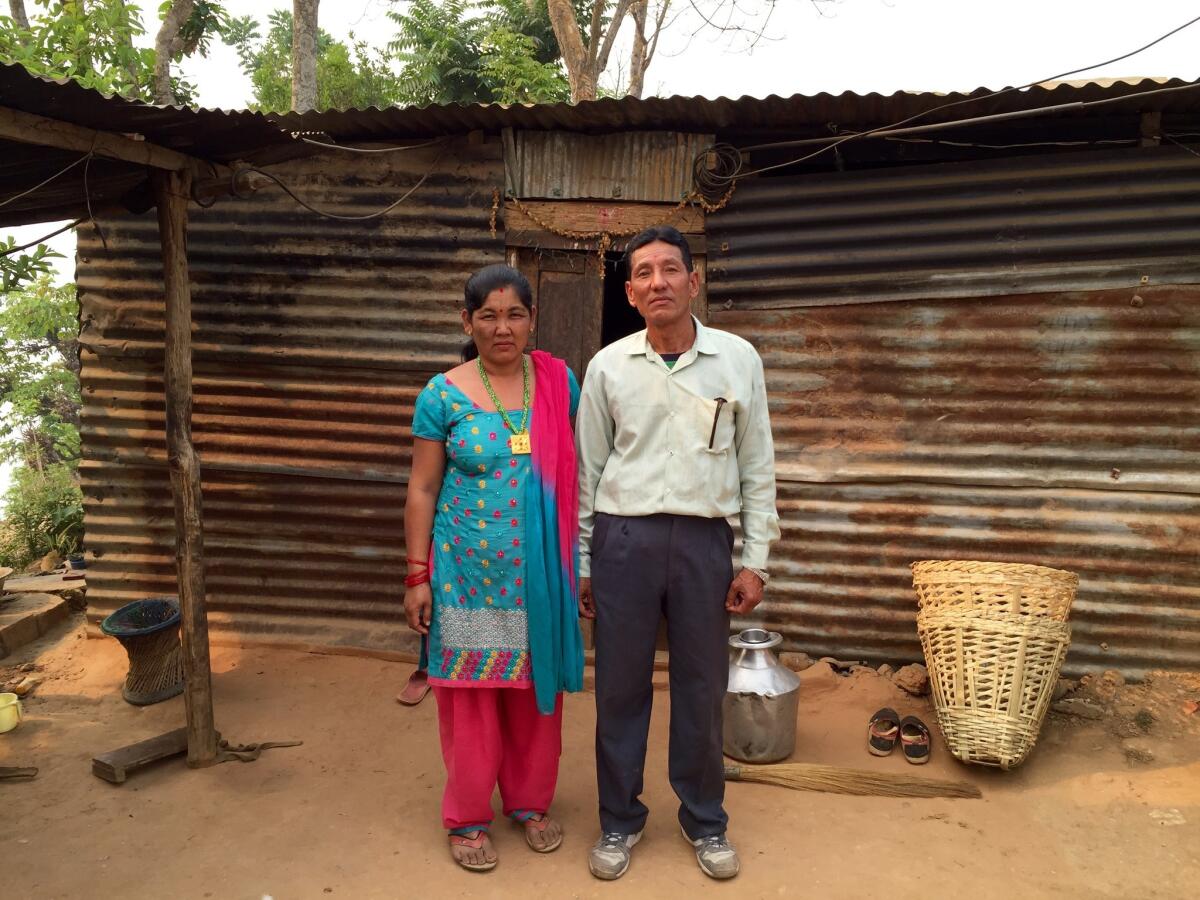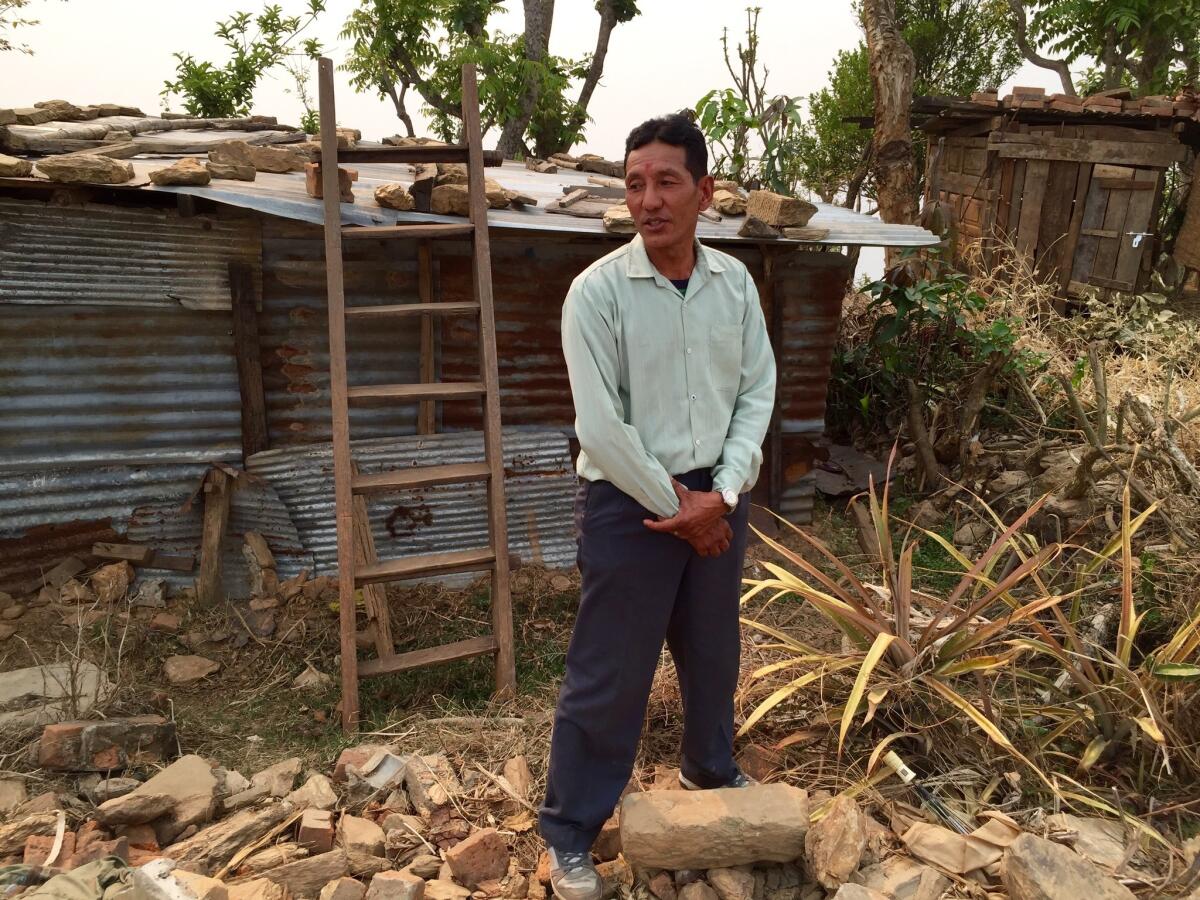A year after Nepal’s 7.8-magnitude earthquake, reconstruction has barely begun

Raj Kumar Sahi and his wife, Madhu Sahi, outside their temporary home in Paslang, Nepal.
Reporting from PASLANG, Nepal — Within days of the magnitude 7.8 earthquake that nearly wiped this hilltop hamlet off the map, Raj Kumar Sahi began building a shed to shelter his family, salvaging twisted metal sheets and splintered strips of wood from the rubble of their four-room home.
A year later, the shed has taken on an air of permanence. A satellite dish crowns the tin roof and electrical cables snake through the panels that serve as walls. The dirt entryway is neatly swept. Above the door hangs a withered garland, a remnant of a festival several months ago.
The house still lies in a heap of stone and bricks, a constant reminder that the family – like nearly all of Nepal’s quake victims – has not received funds the government promised for reconstruction.
“I knew it would be slow, so we built the shed right away,” Sahi said. “But I didn’t think we would be here for a year. And the way things are going, I cannot say how many more months or years it will be like this.”
Despite a worldwide outpouring of grief and assistance that followed last year’s April 25 earthquake, which killed nearly 9,000 people and damaged or destroyed 1 million homes, Nepal’s recovery has barely gotten off the ground.
The government agency charged with overseeing the biggest humanitarian operation in the Himalayan nation’s history has been stymied by political infighting and mired in bureaucratic delays. Work commenced only in January.
Little of the $4.1 billion pledged at an international donor conference in June has been spent, triggering frustration among diplomats in the United States and other countries, some of which have signaled they might shave their contributions.
See more of our top stories on Facebook >>
Reconstruction officials said last week that they were still finalizing damage assessments in 11 of the hardest-hit districts, the first step toward releasing $2,000 grants for families to rebuild their homes.
Across 8,000 quake-ravaged square miles, which include some of Asia’s most majestic and forbidding terrain, victims are facing the prospect of enduring a second consecutive summer monsoon in flimsy sheds, flood-prone and inviting to mosquitoes.

Raj Kumar Sahi outside his temporary home in Paslang, Nepal.
“Sadly, it’s quite simple: Reconstruction hasn’t begun,” said Chandan Sapkota, an independent analyst who until last year served as an economist for the Asian Development Bank in Nepal.
“The kind of urgency you saw in the months after the quake has been lost. The government is stuck in the process. The current environment is confusion at the planning level and uncertainty at the village level.”
In Paslang, a village of about 300 people just 12 miles from the quake’s epicenter in north-central Nepal, 50 of 56 homes were flattened and two people killed, including a 1-month-old boy. When a Times reporter visited Paslang five days after the quake, residents were picking through the debris and had just received the first truckloads of blue tarpaulin sheets, medical kits and other emergency supplies from local and international relief groups.
The village, overlooking terraced fields that tumble down to a forested valley, seems little changed since then. The blue tarps that sheltered people in the temblor’s immediate aftermath have been replaced by tin-and-timber shacks. The piles of stone and mud debris have yet to be cleared.
NEWSLETTER: Get the day’s top headlines from Times Editor Davan Maharaj >>
A few stray possessions poke out from the detritus of the Sahi home – a cotton jacket, a mosquito net, a mangled umbrella – but most of the family’s belongings remain trapped underneath. Sahi, a bank security guard in the capital, Katmandu, had to borrow money to build the shack that would house his wife and two daughters, a bamboo shelter for their two cattle and a chicken coop.
The only space they had was the small plot next to their house where they grew maize and vegetables. With no sign that the government would quickly release reconstruction money, Sahi and his family made the agonizing decision to cover the plot in dirt so they could build atop it – choosing shelter over a reliable source of food and income.
“That was disheartening,” said Sahi, a slender man with deep creases around his eyes. “But we did not have a choice.”
At every step they have faced delays and setbacks. An initial $150 government grant for temporary shelter took months to arrive, and Sahi’s mother, whose house next door was also destroyed, was declared ineligible because she did not hold a deed to the land. Sahi used his grant to build her a shelter.
A second payment of $100 to help quake victims prepare for the winter did not reach them until last month.
During the cold season, as the hillsides grew barren and temperatures hovered near freezing, the wind whipped through the tin walls as they slept. Sahi’s wife, Madhu, took ill and the family depleted its savings to pay for her medical care in Gorkha, the district headquarters a few miles away.
She said she has lost count of the number of officials and engineers who have visited the village to survey the damage.
“A lot of people come, ask questions, take pictures and write down information,” she said. “But we haven’t received anything.”
Nepal’s government, fractious and often dysfunctional even in good times, responded to the quake by pushing through a long-delayed constitution that turned out to be extremely divisive. Protests paralyzed the government while India, which was unhappy with the new constitution, imposed a five-month, de facto blockade that deprived Nepal of its main fuel source and drove up the cost of construction materials.
Parties squabbled over control of the newly formed Nepal Reconstruction Authority, which was not formally authorized until eight months after the quake. Even before it launched, its well-regarded chief executive was replaced by a compromise choice. Since then, analysts say, it has struggled to recruit staff because bureaucrats are reluctant to join an agency that is seen as highly politicized and saddled with a mammoth task.
Housed in a low-slung, prefab building in a government complex in Katmandu, the agency’s offices were nearly deserted on a recent morning. A young clerk sat at a desk, updating her Facebook page. The only sounds were the whirring of ceiling fans and the booming voice of spokesman Ram Thapaliya, who was defending the agency to a succession of foreign journalists.
“In the last three to four months we have done a lot,” Thapaliya said, listing the guidelines it had approved for distributing the cash grants and rules published for building quake-resistant structures. But those moves only created more confusion. Quake survivors who began rebuilding months ago were told they wouldn’t receive grants if their houses did not conform to the new rules.
Thapaliya said about $650 million of the pledged foreign assistance is ready to be disbursed, but analysts say donors are raising questions about whether the government can spend the full $4.1 billion within five years, the lifespan of the agency.
“There’s great disappointment among the international community about the response to the quake,” said Tim Johnston, Asia director for the International Crisis Group. “All governments around the world are cutting budgets savagely, and it would be naive to think that Nepal’s slow response won’t make it harder to get the money that has been pledged for reconstruction disbursed.”
Last month, several villages were cleared to receive the first of the $2,000 grants, which are to be distributed in three installments. Paslang was not on the list. Many villagers believe that politicians are directing aid money to their constituent areas first.
Sahi noted that the surrounding district of Gorkha gave rise to Prithvi Narayan Shah, the 18th century ruler who united several kingdoms into what eventually became Nepal. These days, he said, Paslang and surrounding communities are forgotten by the political elites in Katmandu.
“We had historical importance to Nepal,” he said. “But today there is no one in this village who has access to the powerful.”
ALSO
No more peace talks with Taliban, Afghanistan’s president says
How Japan came to rank worse than Tanzania on press freedom
Islamist militants suspected in slaying of professor in Bangladesh
More to Read
Sign up for Essential California
The most important California stories and recommendations in your inbox every morning.
You may occasionally receive promotional content from the Los Angeles Times.











